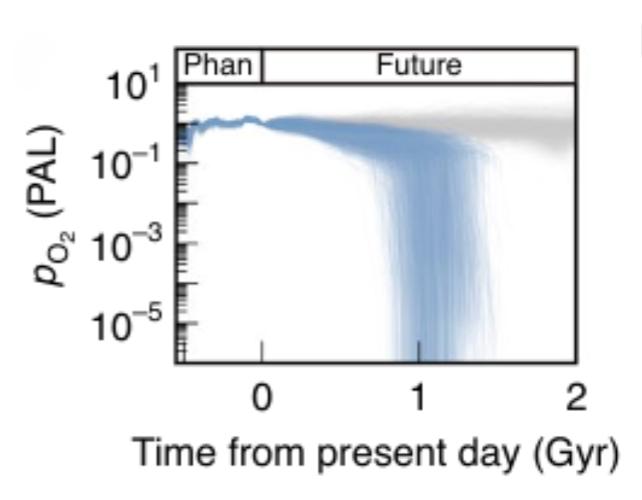| IN A NUTSHELL |
|
Our planet Earth, with its oxygen-rich atmosphere, is currently a haven for life. Yet, this was not always the case, and according to recent scientific predictions, it might not remain so indefinitely. Research published in 2021 suggests that in about a billion years, Earth’s atmosphere will revert to a state rich in methane and low in oxygen, reminiscent of the pre-Great Oxidation Event era. This shift, though distant, will occur rapidly once initiated, signaling a significant transformation in the planet’s habitability. This article delves into the dynamics of this atmospheric shift and its implications for life on Earth and beyond.
The Great Oxidation Event and Its Legacy
The Great Oxidation Event (GOE), which occurred approximately 2.4 billion years ago, marked a pivotal shift in Earth’s atmospheric composition. Prior to this event, Earth’s atmosphere was devoid of free oxygen, a condition that changed dramatically as photosynthetic organisms began releasing oxygen as a byproduct. This transition paved the way for aerobic life forms to evolve and diversify. However, scientists like Kazumi Ozaki from Toho University caution that this oxygen-rich state is not guaranteed to last indefinitely. Their research indicates a future scenario where atmospheric oxygen will diminish drastically, challenging the very foundation of life as we know it.
The model proposed by researchers suggests that the gradual brightening of the Sun and the geochemical cycles governing Earth’s atmosphere will lead to a continuous decline in atmospheric CO2. This decline is expected to precede a sharp drop in oxygen levels, taking us back to conditions similar to the Archaean Earth. Such a transformation underscores the transient nature of our current atmospheric state, with profound implications for the future of life on our planet.
The world’s mightiest ocean current crumbles as unprecedented Antarctic ice melt rewrites history
The Role of the Sun in Earth’s Atmospheric Evolution
The Sun, our life-giving star, plays a crucial role in shaping Earth’s atmosphere. As it ages, the Sun becomes progressively brighter, impacting the planet’s climate and atmospheric composition. This increase in solar radiation is expected to intensify the breakdown of carbon dioxide, crucial for photosynthesis, and consequently reduce the number of photosynthesizing organisms like plants. This reduction will lead to a decline in atmospheric oxygen, essential for most terrestrial life forms.

According to the research, the deoxygenation of Earth’s atmosphere will occur before the onset of moist greenhouse conditions, which are predicted to eventually evaporate Earth’s oceans. This timeline suggests that the loss of oxygen will be the primary driver of extinction for oxygen-dependent life forms, potentially outpacing the effects of ocean evaporation. Such insights highlight the intricate interplay between solar dynamics and Earth’s atmospheric processes, dictating the planet’s habitability timeline.
Implications for Exoplanetary Research
The study’s findings extend beyond Earth, offering valuable perspectives for the search for life on exoplanets. As astronomers develop increasingly powerful telescopes, identifying biosignatures becomes paramount. Traditional searches often focus on oxygen as a key indicator of life; however, this research suggests that oxygen may not be a permanent feature of habitable worlds. Consequently, scientists may need to consider other biosignatures to increase the likelihood of detecting extraterrestrial life.
The research, part of NASA’s NExSS project, emphasizes the importance of understanding planetary habitability in a broader context. By acknowledging the potential for drastic atmospheric shifts, scientists can refine their search criteria, enhancing our ability to recognize signs of life in the Universe. This broader perspective not only enriches our understanding of exoplanets but also deepens our appreciation for Earth’s unique and dynamic history.

Booms From Above: These Mysterious Skyquakes Are Stumping Experts Worldwide
The Future Landscape of Life on Earth
As Earth’s atmospheric composition evolves, the planet will eventually transition to a state dominated by anaerobic life forms. According to the models, the post-deoxygenation atmosphere will have elevated methane levels, reduced CO2, and a lack of ozone protection. While this environment will be inhospitable to humans and many current species, microbial life may continue to thrive, adapting to the new conditions.
This projection raises profound questions about the longevity of complex life on Earth and humanity’s role in this evolving biosphere. As the potential end of oxygen-rich conditions approaches, albeit in the distant future, it underscores the imperative for humanity to explore and possibly inhabit other worlds. This foresight challenges us to contemplate the resilience of life and our place within the cosmos.
The notion of Earth’s atmosphere undergoing such radical changes invites us to reflect on the planet’s long-term habitability and humanity’s future. As the research indicates, the presence of oxygen is not a permanent hallmark of a habitable planet. This realization compels us to consider: What strategies should we pursue to ensure the survival of intelligent life, both on Earth and in the vast expanse of space?
Did you like it? 4.4/5 (20)








Is this really happening in a billion years or is it sooner than we think? 😱
Thanks for the article! Always fascinating to learn about Earth’s future. 🌍
So, are we supposed to start building bunkers? 🤔
How credible is this research? Seems a bit far-fetched.
Great article, but I think we have more immediate issues to worry about!
Will humans even be around in a billion years to witness this? 👀
The sun getting brighter is a new one for me, interesting read!
Can we do anything to prevent this oxygen decline?
Why worry about something happening a billion years from now?